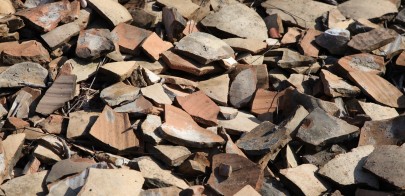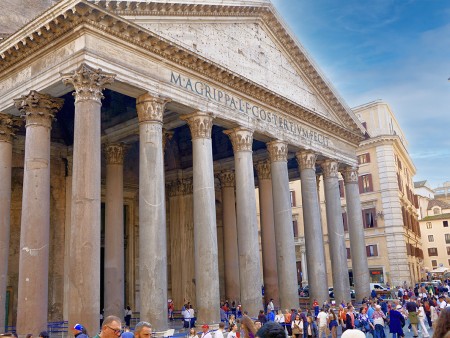Monte Testaccio Tour: the ceramic vases' dump in Imperiale Rome
Private Tour of Monte Testaccio: the massive trade of Imperial Rome and traces of roman products in the stacked oil jars, shaping a hill
Explore Monte Testaccio on our private tour of Rome. This artificial hill of over 50 meters high and with a diameter of 1 kilometer, was created in Imperial Rome through the systematic accumulation of non-reusable terracotta vessels for transporting oil, thus reduced to fragments and properly stacked.
Where did so many terracotta jars come from, and why were they systematically disposed of in the largest landfill of ancient Rome?
Our knowledgeable and communicative guide will address this and other topics of great interest, such as widespread goods and the global economy in Imperial Rome, during your guided tour uncovering the details - the shapes and inscriptions - impressed on the jars and their ability to transport us to the time when those terracotta containers were transported, registered, archived, and disposed of.
On these traces of life, we will lead you into Imperial Rome, through the social and economic dynamics of the greatest metropolis of antiquity.
Unearth the layers of Rome’s past at Mount Testaccio and continue your journey beneath the surface with our Trevi Fountain Underground Tour.
Otherwise, let our Colosseum Guided Audio Tour bring the gladiatorial tales of Rome to life.
Duration
1 hour
Private Tour
TOUR INCLUDES
Special Opening and entrance ticket to Monte Testaccio
Licensed guide with degree in archaeology, history or art history
Dynamic Passionate Guides, with perfect English and narrative skills
Wonders discovered
Did Imperial Rome truly develop the first global economy of antiquity?
Monte Testaccio is a remarkable archaeological evidence of the widespread commerce and decentralized agricultural production policies implemented in the Roman Empire, as well as the efficiency with which the Romans organized the influx and storage of these goods in Rome. This was done in the large imperial warehouses, located not far from the docking of ships near the Tiber Island.
In our Monte Testaccio tour, you will discover how goods from diverse provinces of the empire arrived at the port town of Ostia. Goods from the various provinces of the empire arrived at the port town of Ostia - today, it's possible to visit its streets, taverns, public and private buildings in the archaeological site of Ostia Antica - and were then transported up the Tiber River until reaching the port of Rome. There, they were registered and deposited in the large warehouses located in the area of present-day Testaccio.
Thanks to the engaging narration of our licensed guide, you will explore Monte Testaccio, or the hill of potsherds, as the Romans call it: an artificial hill that formed over the course of nearly three centuries (from the end of the 1st century BC to the middle of the 3rd century AD) from the systematic accumulation, in this designated dumping area, of emptied and shattered vases (as they were not reusable) and properly piled up here.
The amphorae, not surprisingly, were those used for transporting olive oil to Rome, mainly coming from the area of present-day Andalusia in southern Spain, where vast hills were cultivated with olive trees for olive oil production. Anyone who has had the opportunity to use oil containers to transfer traditionally produced olive oil from certain regions of Italy into the cities - such as, in the case of the writer, from the olive mills of Sicily to Rome - knows that removing oil leftovers is not easy, and cleaning would have been even more challenging for pottery containers, which are porous and easily soaked with the viscosity of oil. This is why the Romans chose to discard them; the cost and effort of cleaning the amphorae were evidently too high, and it made more sense to use new ones.
But what were the key factors behind the economic power of the Roman Empire? Let's examine three decisive ones.
The extent of Imperial Rome was immense and never reached before by other empires. During its peak, from the 1st to the 3rd century AD, the Roman Empire, thanks also to a certain political stability, dominated a vast territories of three continents: Europe, Africa, and Asia. Morever all the regions surrounding the Mediterranean were under the dominion of Rome, so much so that the Romans - not without propagandistic intentions - called the Mediterranean "Mare Nostrum" (Our Sea). From Spain to Egypt, from North Africa to present-day France (the Roman Gaul), from Syria to Romania, the official language was Latin, the laws were those of Rome, the power was in the hands of Rome, the eternal city, a myth, and a certainty.
Such a domain facilitated extensive trade networks and economic interactions, making it a global economic powerhouse of its time.
The Romans are famous for their remarkable engineering skills and related infrastructure development. In fact, they conveniently linked the various regions of the empire, not only for military, land control and border defence purposes, developing a series of roads, including the famous "Roman roads" still existing, which greatly facilitated trade and transportation of local goods even between distant provinces far from each other. But this primarily happened through migrations of peoples, an exchange of cultures among men and women with diverse customs, enticed or conquered by Roman culture, whose immense spread is still evidenced today by archaeological findings existing from Morocco to Turkey, from France to Egypt.
The third relevant factor was the adoption of a unified currency system: the Romans indeed adopted their currency - the sestertius - as the sole currency throughout the empire, thereby generating strong economic stability. Roman coins, accepted in the most diverse regions of the empire - as confirmed by numerous archaeological findings scattered all over - fostered a solid economic integration.
Nonetheless, the Roman economy remained fundamentally agrarian, but the Romans initiated policies to optimize agricultural cultivation, which inevitable led, for example, to a predominant production of wheat in Egypt, oil from Spain, and wine from Gaul.
But Italy and above alla Rome, the metropolis with over a million inhabitants in the 1st century AD, remained the main reference market where goods produced in various regions of the empire, and even beyond, flowed and found wealthy buyers for both common and exotic delights.
Request your Private Tour
From € 79
Fill Out The Form Below
By submitting this form I agree to the processing of my personal data as indicated in the privacy policy
Last Reviews
[5.0]
We greatly enjoyed our tour with Yevgen to Mount Testaccio. He was very competent, charming and we had a very good time!
Tour date: 6 February 2024
You may also like ...








